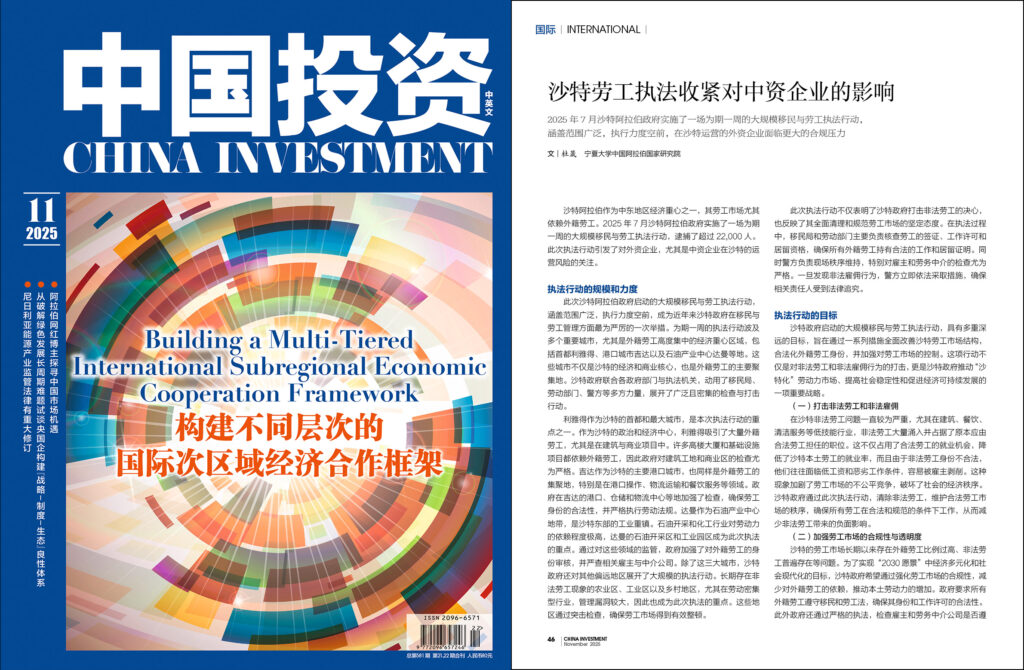
文|杜晟 宁夏大学中国阿拉伯国家研究院
导读
●执法行动的规模和力度
● 执法行动的目标
● 非法雇佣的法律规定
● 劳工执法强化对中资企业的影响
沙特阿拉伯作为中东地区经济重心之一,其劳工市场尤其依赖外籍劳工。2025年7月沙特阿拉伯政府实施了一场为期一周的大规模移民与劳工执法行动,逮捕了超过22,000人。此次执法行动引发了对外资企业,尤其是中资企业在沙特的运营风险的关注。
执法行动的规模和力度
此次沙特阿拉伯政府启动的大规模移民与劳工执法行动,涵盖范围广泛,执行力度空前,成为近年来沙特政府在移民与劳工管理方面最为严厉的一次举措。为期一周的执法行动波及多个重要城市,尤其是外籍劳工高度集中的经济重心区域,包括首都利雅得、港口城市吉达以及石油产业中心达曼等地。这些城市不仅是沙特的经济和商业核心,也是外籍劳工的主要聚集地。沙特政府联合各政府部门与执法机关,动用了移民局、劳动部门、警方等多方力量,展开了广泛且密集的检查与打击行动。
利雅得作为沙特的首都和最大城市,是本次执法行动的重点之一。作为沙特的政治和经济中心,利雅得吸引了大量外籍劳工,尤其是在建筑与商业项目中。许多高楼大厦和基础设施项目都依赖外籍劳工,因此政府对建筑工地和商业区的检查尤为严格。吉达作为沙特的主要港口城市,也同样是外籍劳工的集聚地,特别是在港口操作、物流运输和餐饮服务等领域。政府在吉达的港口、仓储和物流中心等地加强了检查,确保劳工身份的合法性,并严格执行劳动法规。达曼作为石油产业中心地带,是沙特东部的工业重镇。石油开采和化工行业对劳动力的依赖程度极高,达曼的石油开采区和工业园区成为此次执法的重点。通过对这些领域的监管,政府加强了对外籍劳工的身份审核,并严查相关雇主与中介公司。除了这三大城市,沙特政府还对其他偏远地区展开了大规模的执法行动。长期存在非法劳工现象的农业区、工业区以及乡村地区,尤其在劳动密集型行业,管理漏洞较大,因此也成为此次执法的重点。这些地区通过突击检查,确保劳工市场得到有效整顿。
此次执法行动不仅表明了沙特政府打击非法劳工的决心,也反映了其全面清理和规范劳工市场的坚定态度。在执法过程中,移民局和劳动部门主要负责核查劳工的签证、工作许可和居留资格,确保所有外籍劳工持有合法的工作和居留证明。同时警方负责现场秩序维持,特别对雇主和劳务中介的检查尤为严格。一旦发现非法雇佣行为,警方立即依法采取措施,确保相关责任人受到法律追究。
执法行动的目标
沙特政府启动的大规模移民与劳工执法行动,具有多重深远的目标,旨在通过一系列措施全面改善沙特劳工市场结构,合法化外籍劳工身份,并加强对劳工市场的控制。这项行动不仅是对非法劳工和非法雇佣行为的打击,更是沙特政府推动“沙特化”劳动力市场、提高社会稳定性和促进经济可持续发展的一项重要战略。
(一)打击非法劳工和非法雇佣
在沙特非法劳工问题一直较为严重,尤其在建筑、餐饮、清洁服务等低技能行业,非法劳工大量涌入并占据了原本应由合法劳工担任的职位。这不仅占用了合法劳工的就业机会,降低了沙特本土劳工的就业率,而且由于非法劳工身份不合法,他们往往面临低工资和恶劣工作条件,容易被雇主剥削。这种现象加剧了劳工市场的不公平竞争,破坏了社会的经济秩序。沙特政府通过此次执法行动,清除非法劳工,维护合法劳工市场的秩序,确保所有劳工在合法和规范的条件下工作,从而减少非法劳工带来的负面影响。
(二)加强劳工市场的合规性与透明度
沙特的劳工市场长期以来存在外籍劳工比例过高、非法劳工普遍存在等问题。为了实现“2030愿景”中经济多元化和社会现代化的目标,沙特政府希望通过强化劳工市场的合规性,减少对外籍劳工的依赖,推动本土劳动力的增加。政府要求所有外籍劳工遵守移民和劳工法,确保其身份和工作许可的合法性。此外政府还通过严格的执法,检查雇主和劳务中介公司是否遵守劳动法规,确保他们不通过违法手段雇佣非法劳工。通过这些措施,沙特政府为提高劳工市场的透明度,提升企业对劳工市场合规性的认识,创造一个更公平、透明、可持续的工作环境。
(三)促进社会稳定与治安
非法劳工的存在不仅影响经济秩序,还可能加剧社会治安问题,非法劳工通常居住在非法聚集区,环境恶劣,容易引发社会不满和治安问题。由于缺乏合法身份,这些劳工通常无法获得法律保护,容易遭遇剥削和虐待。沙特政府通过清除非法劳工,减少这些潜在的社会问题,促进社会稳定,创造一个更加安全、和谐的社会环境。
(四)保护合法劳工的权益
非法劳工的存在压制了合法劳工的权益,许多合法劳工由于非法劳工的低工资和恶劣工作条件,难以获得公平的待遇。这不仅影响了合法劳工的收入和生活质量,还导致了劳动力市场的失衡。沙特政府通过此次执法行动,旨在打击非法劳工的蔓延,减少非法劳工对合法劳工市场的冲击,确保合法劳工能够享有更加公平和有保障的就业机会。通过清理非法劳工,政府为沙特本土劳工提供了更多的就业机会,保障其基本的工资和工作条件,从而提高整体社会福利水平。
(五)推动社会经济结构转型
为了实现“2030愿景”中经济多元化的战略,沙特政府必须减少对外籍劳工的依赖,并推动更多沙特国民进入劳动力市场,特别是在非石油领域。沙特在过去几十年中,外籍劳工占据了劳动力市场的大部分,尤其在建筑、石油和服务业等行业,外籍劳工的比例高达70%以上。通过此次执法行动,沙特政府减少外籍劳工的数量,为沙特公民创造更多的就业机会,推动经济多元化进程,助力社会经济结构的转型。
通过打击非法劳工、促进劳工市场合规性、保障合法劳工权益、增强社会稳定以及推动社会经济结构转型,沙特政府希望通过这一系列措施为国家的长期发展奠定坚实基础。
非法雇佣的法律规定
沙特阿拉伯的非法雇佣问题一直以来都是劳工市场管理中的一个重要挑战,特别是在外籍劳工占据主导地位的行业中。为了规范劳工市场,沙特政府出台了一系列针对非法雇佣的法律规定,遏制非法劳工的雇佣行为,确保所有劳工都在合法、受保护的条件下工作。根据沙特的劳动法,所有外籍劳工必须在合法的工作许可和签证框架内雇佣,并且不能从事与其签证类型不符的工作。任何雇主如果雇佣了未经过正式程序批准的外籍劳工,或将劳工安排在未经许可的工作岗位上,都将被视为非法雇佣。
当地政府对于非法雇佣行为采取了极为严格的立法和监管措施。首先所有雇主在雇佣外籍劳工时,必须通过沙特劳动局或移民局的正式渠道申请工作许可。这些劳工必须拥有合法的工作签证,并且只能在特定行业和岗位上从事工作。非法雇佣者包括那些聘用没有合法工作签证的劳工,或者雇佣身份不符的劳工,例如将持有旅游签证的人员安排为长期员工。沙特政府对劳务中介公司也有明确规定,要求其必须获得政府批准才能进行劳工中介业务。未经许可的中介机构若参与非法劳工招募,则会面临法律制裁。为了加大打击非法雇佣的力度,沙特政府实施了一系列严格的惩罚措施。非法雇佣的雇主将面临高额罚款,甚至被禁止继续雇佣外籍劳工。根据沙特的法律,雇主如果被发现雇佣了非法劳工,可能会被处以50,000到100,000沙特里亚尔的罚款。如果是重复违法,罚款金额和处罚的严重程度将进一步提高,甚至可能面临刑事责任。同时非法劳工的雇主还可能面临暂停营业或吊销执照等行政处罚,这对企业的运营和信誉造成严重影响。沙特政府的这些惩罚措施不仅对雇主形成了强有力的震慑,也从根本上减少了非法雇佣现象的发生。
劳工执法强化对中资企业的影响
沙特政府加强劳工市场管理的这项执法行动,不仅是推动“沙特化”政策的关键一步,也是减少外籍劳工依赖、增加本土劳动力就业机会、促进社会稳定与经济结构转型的重要举措。对于在沙特运营的外资企业,尤其是中资企业,这意味着面临更大的合规压力,必须更加重视劳工身份的合法性和雇佣过程中的合规性。首先沙特政府对外籍员工的雇佣比例设定了严格要求。企业如果过度依赖外籍劳工,可能会面临罚款、吊销执照,甚至业务受限的风险。其次本地劳工的工资和福利普遍高于外籍劳工,加上对员工进行培训的投入,整体用工成本将显著增加。此外企业还需要满足一系列合规要求,包括签证管理、劳动合同备案和工资保障等,导致人力资源管理的复杂性和行政负担大幅上升。在经营与项目执行层面,中资企业也面临着诸多挑战。由于外籍劳工的配额限制,部分工程项目可能出现技术工人短缺,进而导致工期延误。与此同时,随着劳工维权渠道的畅通,劳资纠纷和诉讼风险显著增加。在工程承包和基础设施建设中,如果本地劳工的技能或效率不足,企业往往需要增加培训投入或依赖分包商,这不仅推高了合同履约成本,还增加了项目执行的不确定性。
尽管如此,这一政策环境的变化也为中资企业带来了新的机遇。通过积极推进本地化战略,与沙特的高校及职业培训机构合作培养本土人才,企业不仅能够提升长期竞争力,还能更好地契合“愿景2030”的政策方向,从而获得更多政府支持和公共项目的机会。这一举措也有助于推动企业管理体系的正规化和数字化进程,提高整体合规性与治理水平,最终实现价值链的升级与优化。

